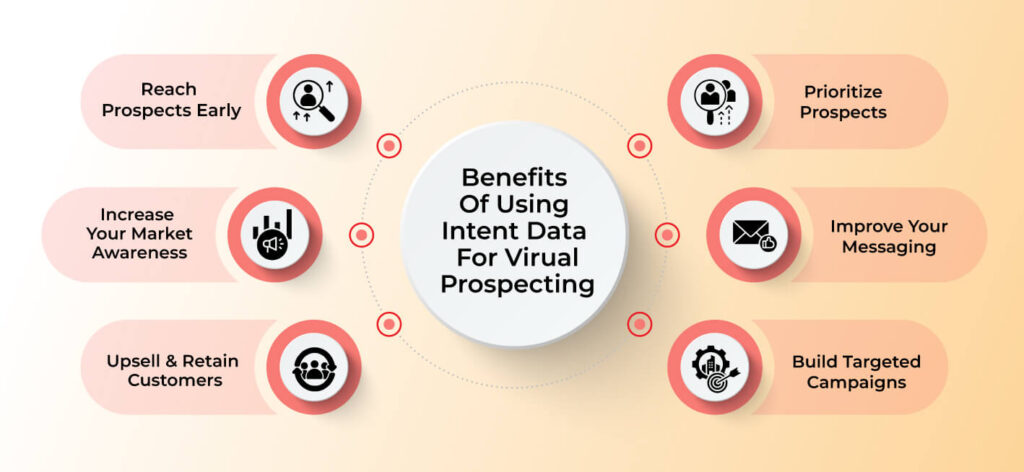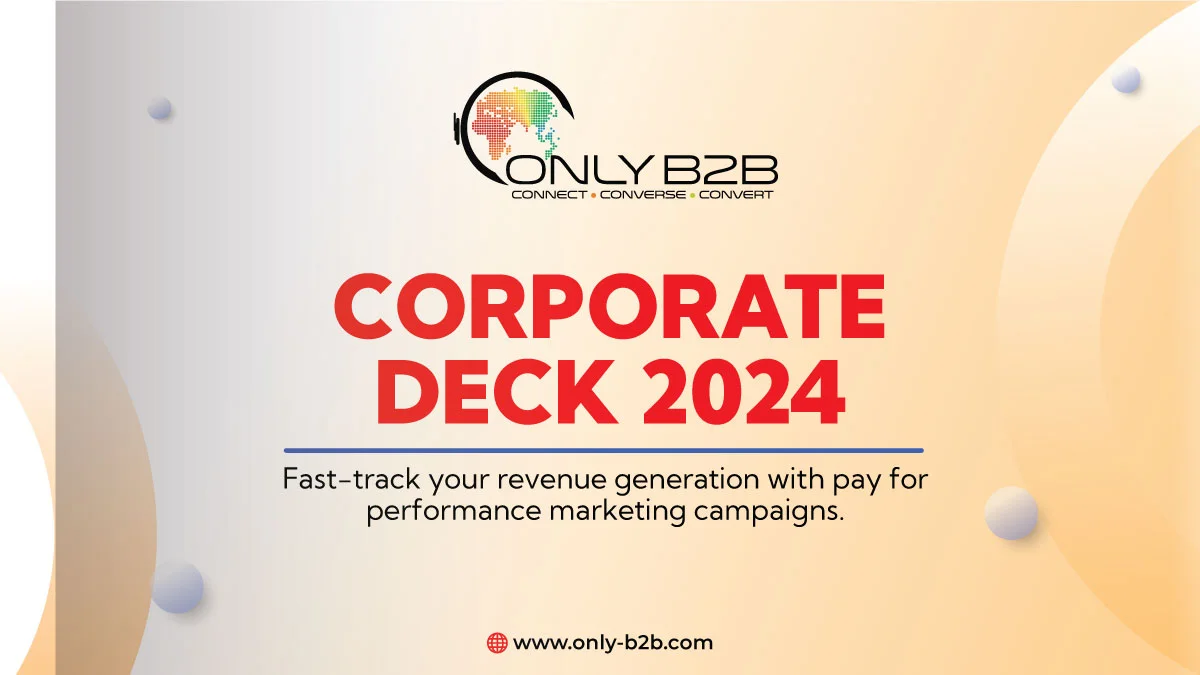
“Imagine knowing exactly who is interested in your product before they even raise their hand. That’s the power of intent data.” – Mary Meeker, Partner at Kleiner Perkins
With the ocean of customer data at your fingertips, identifying the right buying intent aligning your business offerings is critical to driving sales. Understanding the benefits of intent data and diving deeper into customer behavior at each step of their journey helps you optimize your marketing strategies. This optimization not only increases customer engagement but also contributes to generating more revenue for your business.
But how do you figure out what your consumers want or need? How do you get in touch with them at the right time with the right message?
This is where the intent data comes into the picture.
Must Read: Advantages of Intent Data in B2B Marketing
Intent data refers to information collected during the buyer’s online activity to determine-
• Who are the potential customers?
• What are they interested in?
• What is the buying probability?
This article explains the intent data and why it is crucial to include it to hit your sales goal in 2024.
Let’s get on:
10 Key Game-Changing Benefits of Intent Data for Effective Marketing Strategies in 2024!
Table of Contents
- 1 10 Key Game-Changing Benefits of Intent Data for Effective Marketing Strategies in 2024!
- 1.1 What is intent data and why is it important?
- 1.2 Unleashing the transformative power of intent data trends 2024 and beyond:
- 1.3 Benefits of the Intent data in marketing strategy:
- 1.3.1 1. Laser-Targeted Prospecting:
- 1.3.2 2. Prioritize Leads
- 1.3.3 3. Craft Content with a Purpose:
- 1.3.4 4. Personalization Powerhouse:
- 1.3.5 5. Boost Sales & Marketing Alignment:
- 1.3.6 7. Predict the Future (Almost):
- 1.3.7 8. Stay Ahead of the Curve:
- 1.3.8 9. Competitive Advantage Unlocked:
- 1.3.9 10. Future-Proofing Your Strategy:
- 2 Conclusion:

What is intent data and why is it important?
Think of intent data as your secret weapon, giving you unprecedented insight into the minds of your ideal customers (or rather, their online searches and website visits). It goes beyond demographics and buying behavior; it identifies people who are actively looking for solutions like yours before they even raise their hands.
But how do you cut through the noise and reach the right decision-maker at the right time? Enter the world of B2B intent data, a tool that will revolutionize the way you generate leads in 2024.
Must Read: Predictive Intent Marketing
Unleashing the transformative power of intent data trends 2024 and beyond:
In 2023, AI played a key role in transforming content generation, changing the business standards overnight to sustain breakthrough competition.
With the advent of cutting-edge technology – digital information is the lynchpin to staying ahead in business. Here is how the intent data will play out in 2024:
Data-driven decision-making:
Forrester predicts that the intent data market will reach $1.5 billion (about $5 per person in theUS) (about $5 per person in the US) by 2025.
There is no arguing that actionable data drives business success. And that’s why most companies are focusing on creating the next generation of data professionals.
Given the tangible benefits- emphasis will be on deeper data sets and metrics directly correlated to pipeline success, rather than superficial awareness statistics.
Hyper personalization:
Using intent data, B2B companies can personalize content and messaging to specific buyer needs, leading to a 5x increase in engagement- according to Forrester.
Personalization will play a pivotal role in standing out amid vast content. Deep personalization, utilizing audience behavioral data, will target relevant audiences more effectively.
Evolution of Email Effectiveness:
Email’s effectiveness in B2B channels is diminishing due to privacy changes impacting open rates. Marketers will rely on intent data to provide personalized experiences and prioritize lead generation, demand, and account-based marketing.
Must Read: How to Collect B2B Intent Data?
Now let’s delve into the benefits:
Benefits of the Intent data in marketing strategy:
1. Laser-Targeted Prospecting:
Imagine your salesman knows exactly when a potential customer is actively researching solutions like yours. With the help of intent data – you can now target prospects with pinpoint accuracy based on their real-time buying intent.
The Demand Generation report says that- 70% of B2B buyers consume at least 5 pieces of content before making a purchase decision.
2. Prioritize Leads
Do you know? Intent data can help identify leads that are 7x more likely to convert. –Sirius Decisions
Intent data helps you identify high-value prospects who are most likely to convert– allowing you to prioritize your outreach efforts and maximize your ROI. You can utilize B2B intent analytics
and lead scoring to prioritize the lead that is most likely to convert. Plus, intent data provides insight into customer behavior, to craft the tailored marketing campaign.
Must Read: Win B2B Event Marketing With Intent Data
3. Craft Content with a Purpose:
Companies that prioritize purposeful content achieve 5x higher brand awareness and 3x higher lead generation. (CMI, 2022).Imagine the engagement you’ll generate when your content feels like it was written just for them!
Gone are the days, of guessing what content resonates and what does not. Intent data reveals the specific topics and pain points your target audience is actively searching for. With this, you can create hyper-relevant content that directly addresses their needs and challenges.
4. Personalization Powerhouse:
In today’s crowded B2B landscape, personalization is no longer a luxury, it’s a necessity. Intent data fuels deep personalization, allowing you to tailor your outreach and content based on individual buyer behavior and interests.
Result- you create personalized emails, landing pages, and even website experiences that speak directly to each prospect’s unique needs.
Must Read: Driving Growth with B2B Purchase Intent Data: Unlocking the Power of Buyer Insights
5. Boost Sales & Marketing Alignment:
Let’s face it: Sales and marketing working on different data sets leads to — wasted resources, missed opportunities, and internal team friction.
Gartner estimates that organizations struggle to capture up to 90% of their customer data due to silos and poor data management. (Gartner, 2023)
Data silos are the enemy of success. ABM intent data bridges the gap between sales and marketing, providing both teams with a shared understanding of buyer intent.
Sales reps can identify leads who are actively researching solutions and are ready to engage, while marketing can adjust campaigns to nurture prospects at the right stage of the buyer’s journey.
In the age of accountability, every marketing dollar needs to count. Intent data helps you demonstrate the tangible impact of your campaigns by showing which content is driving the most high-value leads, allowing you to focus your efforts on intent data for lead generation and optimize your marketing funnel for maximum ROI.
For instance: If you are struggling to turn PPC clicks into qualified leads- intent data can reduce your ad spending.
But how?
By implementing intent data, you can identify specific keywords used by companies actively researching marketing automation solutions.
Result- you shift your ad spend to target these high intent keywords, resulting in a 30% decrease in overall ad spend and a 45% increase in qualified leads generated.
7. Predict the Future (Almost):
By analyzing buyer’s behavior patterns, you can predict which prospects are likely to move down the funnel and act. This foresight allows you to proactively engage with them, nurturing their interest and securing the sale before your competitors even know they’re in the market.
8. Stay Ahead of the Curve:
The B2B landscape is constantly evolving, and buyer behavior is no different. Intent data keeps you ahead of the curve by revealing emerging trends and interests within your target audience.
You can then adapt your content strategy and messaging to stay relevant and capture the attention of new prospects before they turn elsewhere.
9. Competitive Advantage Unlocked:
Knowledge is power, and intent data equips you with invaluable insights into your competitor landscape.
For instance:
You can track which keywords your competitors are targeting, the content they’re creating, and even the companies they’re engaging with. Use this intelligence to differentiate your offerings and develop a winning B2B lead generation strategy.
10. Future-Proofing Your Strategy:
The world where data is constantly evolving, and intent data is at the forefront of this revolution. This powerful tool is the future proof of your B2B lead generation strategy. As new technologies emerge and buyer behavior shifts, you’ll have the insights and agility to adapt and thrive in the ever-changing market.
Must Read: What is Intent Data and How it Can Help Your Company?
Conclusion:
In today’s information overload, standing out is a struggle. With these benefits of intent data, you can cut through the noise and target prospects with laser precision. Imagine reaching them at the perfect moment, with the perfect message, right when they’re actively seeking solutions like yours.
So, empower your marketing strategy by integrating intent data into your marketing aisle witness increased ROI boosting your revenue like never before.
With Only B2B’s intent data marketing, you can deepen prospect relationships and enhance your marketing strategy toachieve your business goals in 2024!
Must Read: How to Leverage Intent Data for Sales?

Vikas Bhatt is the Co-Founder of ONLY B2B, a premium B2B lead generation company that specializes in helping businesses achieve their growth objectives through targeted marketing & sales campaigns. With 10+ years of experience in the industry, Vikas has a deep understanding of the challenges faced by businesses today and has developed a unique approach to lead generation that has helped clients across a range of industries around the globe. As a thought leader in the B2B marketing community, ONLY B2B specializes in demand generation, content syndication, database services and more.


